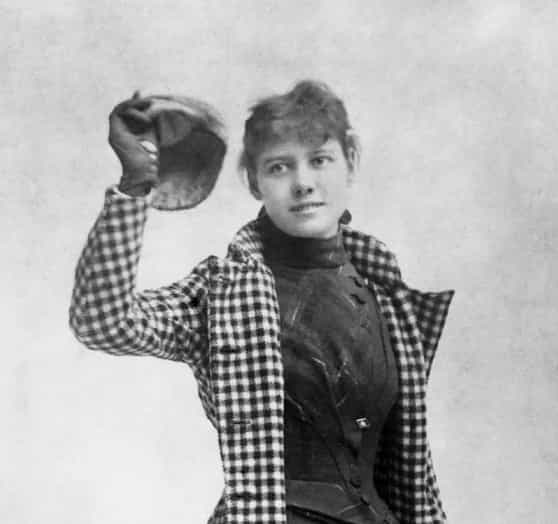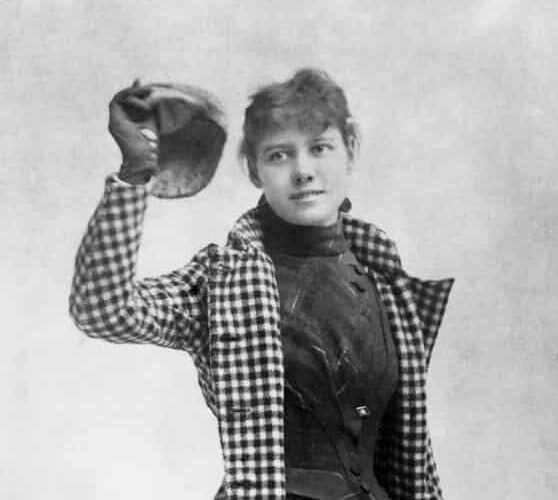Nellie Bly’s Amazing Journey Around the World: A Surprise Race

In the year 1889, an American journalist named Nellie Bly set out on one of the most daring adventures of her time. Her trip around the world was not only filled with courage and determination—it turned into an unexpected race.
This article tells the story of how Nellie Bly, a pioneer of investigative journalism, traveled the globe in record time, all while competing with another reporter from a rival magazine.
Who Was Nellie Bly?
Nellie Bly was born as Elizabeth Jane Cochran in America. She became famous for her daring work as a journalist. Before her famous journey, she had already shown the world her strength and skill in journalism by spending ten days inside a mental asylum. At that time, she was on a mission to show the cruel conditions that people in such institutions faced. This type of work is now known as investigative journalism. Her brave reporting helped change the way people thought about mental health and the treatment of patients.
Nellie Bly was not just a reporter; she was a trailblazer for women and men alike. At a time when journalism was mostly a job for men, she proved that a woman could be just as bold, smart, and resourceful. She broke many barriers in the field of journalism and inspired future generations to pursue stories that mattered.
The Plan: Beating a Fictional Record
Nellie Bly’s most famous journey began with a simple but daring challenge. In 1873, the writer Jules Verne had published a novel about a man named Phileas Fogg who traveled around the world in 80 days. Inspired by this exciting tale, Nellie Bly set herself a goal: to beat that record.
Her aim was to make the trip in fewer days than the 80 days mentioned in the novel. In fact, her goal was to complete the journey in 75 days. With her mind made up and a fierce determination, she set off on a voyage that would change her life and capture the attention of the world.
The Journey Begins: Leaving New York
Nellie Bly started her adventure in Hoboken, New Jersey. From there, she boarded a large steamship called the Augusta Victoria. This ship was not just a means of transport—it was the first step in her long journey across the seas. On board, Nellie was asked a simple question: “Do you get sea-sick?” Her answer was both bold and humorous. She quickly moved to the railing of the ship, determined to face the wild waves head-on.
The journey by sea was not without its challenges. Despite feeling seasick at times, Nellie persevered and reached London, England in just seven days. Her determination and spirit set the tone for what would be a memorable adventure.
A Train Ride Through Europe
Once in London, Nellie’s journey took her by train to Paris, France. Traveling by train in the late 1800s was a new and exciting experience for many. The smooth and fast rides allowed her to cover long distances in a short time. In Paris, Nellie even took a short trip to the city of Amiens. There, she met the famous writer Jules Verne in person.
Meeting Jules Verne was a dream come true. He wished her luck and said, “If you do it in seventy-nine days, I shall applaud with both hands.” His kind words gave her a boost of confidence. This brief encounter with the author of the book that inspired her journey added a personal touch to her adventure and filled her with even more determination.
The Journey Continues: Adventures in Egypt and the Suez Canal
After her visit to Europe, Nellie Bly’s adventure led her to Egypt. The ancient land was a new world for her, full of mysteries and wonders. One of the highlights of this part of her journey was traveling through the famous Suez Canal. The Suez Canal was a critical route that connected Europe with Asia, and it played a key role in global trade. For Nellie, it was another challenge to overcome on her quest to beat the 80-day record.
Her journey was full of exciting moments. Traveling by train, steamship, rickshaw, horse, and even donkey, Nellie experienced the world in many different ways. Each mode of transport brought its own set of challenges and adventures. Yet, through every trial, she remained focused on her goal.
The Surprise Competitor: Elizabeth Bisland
What made Nellie Bly’s journey even more exciting was that she was not alone in this race around the world. Unbeknownst to her, another female reporter named Elizabeth Bisland from Cosmopolitan magazine had also embarked on a similar journey. Elizabeth Bisland, who was known for her refined style and literary taste, was a stark contrast to Nellie’s daring spirit.
While Nellie was ready to take on any challenge, Bisland was more interested in the comforts of life. She enjoyed the elegant salons of New York and had a taste for gracious hospitality. When her editor asked her to join the race, she initially refused. She said she had dinner plans and nothing suitable to wear for such an adventure. However, her editor persuaded her to participate in the journey.
Elizabeth Bisland’s travel writings were filled with poetic descriptions and lyrical observations. She described the Pacific Ocean in vivid terms, comparing its waves to precious stones and deep, mysterious colors. Although her style was very different from Nellie’s straightforward reporting, both women captured the imagination of their readers.
The Unexpected Race
Nellie Bly’s journey was not planned as a competition. She started her trip simply to beat the record set by the fictional character Phileas Fogg. However, fate had another twist in store. On the same day that Nellie left New York, Elizabeth Bisland began her own journey in the opposite direction. This meant that two women were racing around the world, each writing about their experiences for different newspapers.
The realization of this competition came as a shock to Nellie Bly. In one instance, while in Hong Kong on Christmas Day, she went to the office of the Oriental and Occidental Steamship Company to arrange her departure to Japan. There, a man in the office told her that she would lose the race. He casually mentioned that another woman had left for the journey three days earlier. Nellie, surprised and a bit confused, questioned him. She joked by saying, “I am running a race with Time,” emphasizing her determination and wit.
This unexpected twist added an extra layer of excitement to her journey. Despite the news of her competitor, Nellie did not slow down. Instead, she pressed on with even more energy, determined to finish her trip as quickly as possible.
Overcoming Challenges Along the Way
Throughout her journey, Nellie Bly faced many obstacles. The long hours on steamships and trains, the different climates, and the constant change of scenery could have been overwhelming for anyone. But Nellie was not one to give up. She dealt with seasickness, long travel delays, and even unexpected detours with a cheerful attitude and a brave heart.
One memorable moment was when she bought a monkey during a brief stop while waiting for a steamship. Such unexpected events became part of her unique story. Every challenge she faced made her journey more interesting and showed her ability to adapt and overcome difficulties.
Nellie’s journey was also filled with moments of joy and celebration. After a long trip across the Pacific Ocean, she finally returned to the United States. Her arrival in America was met with a hero’s welcome. Crowds gathered at a New Jersey train station to cheer her on. The New York World, the newspaper that had sent her on the mission, even chartered a special train car just for her. The ride was filled with cheerful greetings, congratulatory messages, and beautiful flowers. It was a triumphant end to a remarkable adventure.
A Closer Look at Her Daily Experiences
Nellie Bly’s journey was not just about moving from one country to another; it was about experiencing life in many different parts of the world. In her dispatches sent back to her newspaper, she wrote about everything she saw and felt. Her reports were full of lively descriptions and humor.
For example, on her very first day at sea, she was asked a simple question about sea-sickness. Her witty response and the way she quickly moved to the ship’s railing showed her fearless personality. Throughout her journey, she described the people she met, the food she tasted, and the landscapes she admired with great detail. These reports made her readers feel as if they were on the journey with her.
Even when she met challenges like the long wait in Hong Kong or the delays in the steamship schedules, Nellie kept her spirits high. She wrote about the unexpected detours and funny conversations she had along the way. Her lively style of reporting helped capture the imagination of many, making her a beloved figure in journalism.
The Impact of the Journey on Journalism
Nellie Bly’s trip around the world was more than just a race against time. It was a milestone in the history of journalism. At a time when the idea of women reporters was not widely accepted, her successful journey showed that women could handle challenging assignments just as well as men. Her work helped pave the way for future generations of female journalists.
This journey also marked an important moment in what was known as “yellow journalism.” At that time, newspapers often hired “stunt girls” to boost their sales by covering sensational stories. Although some critics felt that these women were only hired for their dramatic stories, Nellie Bly proved that her reports were full of substance and bravery. She became a respected figure who was known for her detailed and courageous reporting.
Many modern readers may not know about these brave “girl reporters” because their stories have faded from history. Today, journalists and historians study Nellie Bly’s work to understand the challenges and adventures of reporting in the late 19th century. Her legacy reminds us that determination, creativity, and a willingness to take risks can change the world.
A Look at the Rivalry: Nellie Bly vs. Elizabeth Bisland
The unexpected race between Nellie Bly and Elizabeth Bisland added an extra element of drama to the journey. While Nellie was known for her bold and adventurous spirit, Elizabeth Bisland was more reserved. She was the literary editor for Cosmopolitan magazine and often wrote in a more poetic and elegant style.
When Bisland was asked to join the race, she initially did not want to participate. She had social engagements and felt that the attention from such a race was too much for her taste. However, her editor convinced her to take on the challenge. In her travel accounts, Bisland used rich, imaginative language to describe the places she visited. For example, she wrote about the Pacific Ocean in a way that made it sound almost magical, full of deep colors and poetic beauty.
Despite her elegant style, Bisland’s journey was slower compared to Nellie Bly’s. She ended up arriving back in America four days after Nellie. Although both women became famous because of their trips, Nellie’s record-breaking time of 72 days made her the clear winner of the race.
The friendly rivalry between these two women made the race even more interesting. It was a competition that captured the public’s imagination and proved that women could be daring adventurers. Their stories were printed in many newspapers, and people all over the world followed their progress with excitement.
The Journey’s End: A Hero’s Welcome
After traveling by steamship, train, and even by land animals like horses and donkeys, Nellie Bly finally returned to America. Her journey was not only a personal triumph but also a public celebration. When she arrived back in New Jersey on January 25, 1890, a large crowd was waiting for her. People cheered, waved, and sent congratulatory telegrams. Her newspaper, the New York World, had organized a special train to bring her home quickly and in style.
This moment was a turning point in how journalists were seen in society. Nellie’s successful trip proved that a woman could take on dangerous assignments and return with stories that excited and informed the public. Her achievement opened doors for many women in journalism, who went on to write and report on important events around the world.
The celebration of her return was a sign of how much her work had touched people’s lives. The public recognized her bravery, determination, and the spirit of adventure that drove her to break records. This warm reception was not just for her record time but for the remarkable journey she had undertaken—a journey that involved many different cultures, landscapes, and experiences.
How Nellie Bly Changed Journalism Forever
Nellie Bly’s journey was a turning point in the world of journalism. Before her trip, stories about long journeys were often written in a dramatic and exaggerated style, aimed solely at boosting newspaper sales. Nellie’s reports, however, were full of true adventure, real encounters, and honest observations. Her writings not only entertained the readers but also informed them about different cultures and ways of life.
Her work proved that journalism could be both exciting and deeply human. It showed that reporters could take risks to uncover the truth and bring important stories to the public. Her journey set a high standard for future reporters and changed the way newspapers covered big stories.
A Detailed Timeline of the Journey
To help you better understand the incredible scope of Nellie Bly’s adventure, here is a detailed timeline of her journey:
- Departure from New York:
Nellie Bly began her trip by boarding the steamship Augusta Victoria in Hoboken, New Jersey. Her journey started with a bold decision to face the unknown. - Arrival in London:
After a challenging sea voyage, Nellie reached London in just seven days. This quick crossing was a testament to her determination and energy. - Train to Paris:
In London, she quickly switched from sea to land. A train ride took her to Paris, where she also visited Amiens to meet Jules Verne. This meeting boosted her confidence and inspired her further. - Across Europe to Egypt:
Continuing her journey, she traveled through various parts of Europe. Eventually, her path led her to Egypt. There, the ancient lands and the engineering marvel of the Suez Canal provided new challenges and wonders. - The Race in Asia:
While traveling in Asia, Nellie Bly experienced moments of surprise. In Hong Kong, she learned about the existence of another female reporter racing around the world. Despite the shock, she continued on her way to Japan with her characteristic humor and determination. - Crossing the Pacific:
The long journey over the Pacific Ocean was filled with both hardships and delightful surprises. Nellie even took a brief detour to purchase a monkey, an unusual yet memorable moment that added to her colorful adventure. - Return to America:
Finally, after many days of travel by different modes of transport, Nellie Bly returned to America. The New York World organized a special train car for her, and she was met with cheers and celebrations. Her arrival marked the end of an epic journey that lasted 72 days, a new record in world travel.
Frequently Asked Questions
1. Who was Nellie Bly?
Nellie Bly was an American journalist, born as Elizabeth Jane Cochran. She became famous for her daring adventures, especially her record-breaking trip around the world in 72 days, and for her groundbreaking investigative reporting.
2. What record did Nellie Bly set?
Nellie Bly set a world record by traveling around the world in just 72 days. She aimed to beat the fictional record in Jules Verne’s Around the World in Eighty Days.
3. Why did she decide to make this journey?
Inspired by Jules Verne’s novel, Nellie Bly wanted to prove that women could achieve great things. She set out to beat the 80-day record and show that she, and other women, could be just as brave and capable as men.
4. How did Nellie Bly travel around the world?
She traveled by using a mix of steamships, trains, rickshaws, horses, and even donkeys. This combination of transportation methods helped her cover thousands of miles in a very short time.
5. What challenges did she face during her journey?
Nellie Bly faced many challenges, including seasickness, travel delays, and the pressure of racing against time. She also encountered unexpected obstacles, such as a surprise competitor, Elizabeth Bisland, who was on a similar journey.
6. Who was Elizabeth Bisland?
Elizabeth Bisland was another female reporter sent by Cosmopolitan magazine to travel around the world. Although she was a strong competitor, she ultimately finished her journey a few days after Nellie Bly.
7. How did her journey impact journalism?
Nellie Bly’s adventure became a landmark in investigative journalism. Her fearless reporting and record-breaking journey demonstrated that women could take on challenging assignments, which paved the way for future generations of journalists.
8. What were some key places Nellie Bly visited?
During her journey, she visited many important places, including London, Paris, Egypt, the Suez Canal, Colombo in Ceylon (Sri Lanka), Singapore, Hong Kong, and Japan.
9. How was Nellie Bly received when she returned to America?
When Nellie Bly returned to the United States, she received a hero’s welcome. Crowds cheered her on at train stations, and special trains were arranged to celebrate her achievement.
10. What is Nellie Bly’s legacy today?
Nellie Bly is remembered as a pioneering journalist and adventurer. Her daring journey not only set a world record but also broke gender barriers in journalism, inspiring countless women to pursue careers in reporting and exploration.

